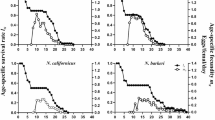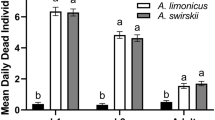Abstract
The pygmephoroid mite, Brennandania lambi (Krczal), is the most serious mite pest of mushroom production in Shanghai. China. This mite could not develop and reproduce on the mycelia of Lentinus edodes, Flammulina velutipes, Pleurotus ostreatus or Pleutotus sajor-caju, but 12–20% of the females survived 15 to 31 days on these hosts, whereas all mites died after 8 days in absence of food. When fed the mycelia of Auricularia polytricha, B. lambi adults could become gravid and reproduce but active larvae failed to develop to the next stage. B. lambi developed and reproduced on the mycelia of Auricularia auricula, Hericium erinaceus, Tremella fuciformis and Agaricus bisporus. Mobile stages of B. lambi damage A. bisporus by feeding on its mycelia. Field surveys of mite damage during 1983–1989 in the suburbs of Shanghai revealed that contaminated spawn was the major source of the mite problem and losses of the crop averaged between 10% and 20%. Experiments on the effects of temperature on mite survival indicate that exposure of mites at 50° C for 1 hour or-10°C for 24 hours killed all stages of B. lambi. Thus, heating treatment during well-executed phase II composting and freezing of mushroom spawn at-10° C for 24 hours should eliminate or at least reduce the damage to mushrooms by this pest.
Similar content being viewed by others
References
Clift A.D and R.B.Toffolon. 1981a. Insects and mites associated with mushroom cultivation on three commercial farms near Sydney, N.S.W., Australia. Mushroom Science, 11(1): 537–549.
Clift A.D and R.B.Toffolon. 1981b. Biology, fungal host preferences and economic significance of two pygmephorid mites (Acarina: Pygmephoridae) in cultivated mushrooms, N.S.W., Australia. Mushroom Science, 11(2): 245–253.
Fletcher J.T., P.E.White and R.H.Gaze. 1986. Mushrooms—Pest and Disease Control. Intercept, Ponteland, Newcastle upon Tyne. 156 pp.
Gao J.-R., P.Zou and E.-P.Ma. 1986. Two new records of mushroom phymephorid mites from China (Acari: Pygmephoridae). Acta Agric. Shanghai, 2(3): 27–32.
Gurney B. and N. W.Hussey. 1967. Pygmephorus species (Acarina: Pyemotidae) associated with cultivated mushrooms. Acarologia, 5: 121–155.
Kaliszewski M and G.Rack. 1986. A systematic study of the mite Microdispus (Premicrodispus) lambi (Krczal, 1964) (Acari: Pygmephoroidea), a mushroom pest in Australia. Mitt. hamb. zool. Mus. Inst., 83: 231–241.
Krczal H. 1964. Pygmephorus lambi eine neue Pyemotidae aus Champignonkulturen. Zool. Angew., 172: 318–322.
Wicht M.C. and R.Snetsinger. 1971. Observations on mushroom-infesting pyemotid mites in the United States. Entomol. News, 82: 183–190.
Wu J.-F. and E.-P.Ma. 1988. Studies on biological characters of Brennandania lambi (Krczal) the most harmful mite for mushroom production in Shanghai region. Acta Agric.Shanghai, 4(3): 41–46
Wu J.-F., L.-D.Liu and E.-P.Ma. 1989. Studies on spatial patterns of Brennandania lambi (Krczal) adults on mushroom beds and their application. Acta Agric. Shanghai, 5(3): 15–19.
Author information
Authors and Affiliations
Rights and permissions
About this article
Cite this article
Wu, J., Zhang, ZQ. Host feeding, damage and control of the mushroom pest, Brennandania lambi (Acari: Pygmephoroidea) in China. Exp Appl Acarol 17, 233–240 (1993). https://doi.org/10.1007/BF00118440
Accepted:
Issue Date:
DOI: https://doi.org/10.1007/BF00118440




